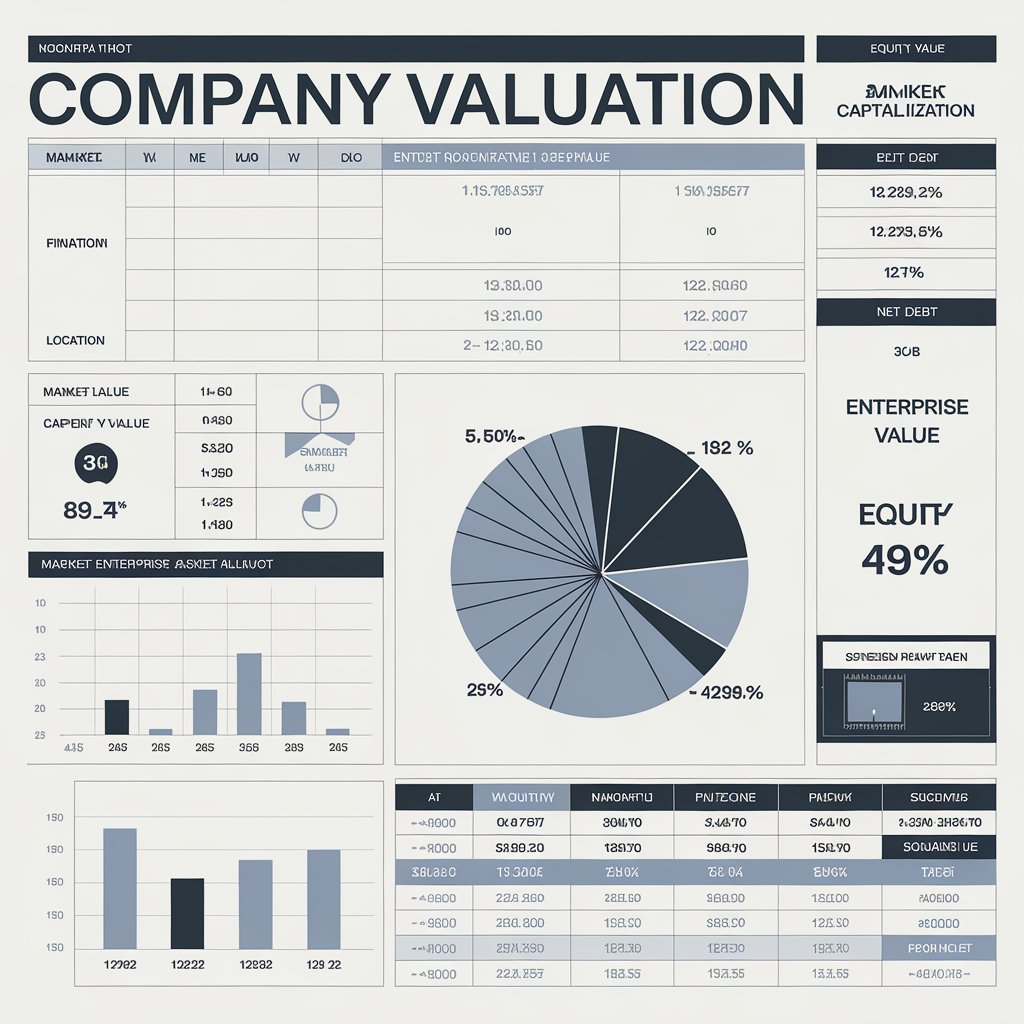Understanding a company valuation is important, especially as it grows and looks to raise money, borrow funds, or sell part of the business.
Before investing, investors examine a company’s financial health and future potential. Valuation is one way to evaluate a business before investing. Several factors influence a company’s valuation, including market trends, industry performance, unique products or technologies, and the company’s growth stage. This article explains what company valuation is and how to calculate it.
What is Company Valuation?
Company valuation is the process of figuring out how much a company is worth. It helps determine the fair value of a company’s stock or business as a whole. To value a company, various factors are considered to see if the company’s stock is undervalued, overvalued, or fairly priced.
When you know a company’s market value (the current price at which its stock can be bought or sold) and its intrinsic value (what the stock is actually worth), you can decide whether to buy, sell, or hold the stock. If the market value is higher than the intrinsic value, it might be a good time to sell. Conversely, if the intrinsic value is greater than the market value, it could be a good opportunity to buy the stock.

How to Calculate Company Valuation
Calculating a company’s valuation doesn’t have a single formula. Instead, there are various methods based on different approaches, each suited for specific purposes. Let’s explore the different methods individuals can use to determine company valuation.
Asset Approach
The Net Asset Value (NAV) is the simplest way to assess a company’s value. To calculate NAV, consider the fair value of all the company’s assets, both depreciating (like equipment) and non-depreciating (like real estate). Each asset’s fair value can differ from its last recorded value or purchase price. This approach works best for companies with many tangible assets, where calculating fair value is more straightforward.
Discounted Cash Flow Approach
The discounted cash flow method estimates how much future cash flows are worth today by applying a discount rate, usually the Weighted Average Cost of Capital (WACC). This method forecasts cash flows over several years and discounts them back to present value, giving an idea of what investors might earn from their investment.
Market Approach
Also known as the relative valuation method, the market approach is commonly used for valuing stocks. It compares a company’s value to similar companies using financial metrics like the Price to Earnings (PE) ratio, Price to Sales (PS) ratio, and Price to Book Value (PBV) ratio. These ratios help assess a company’s performance despite size differences.
- PE Ratio (Price to Earnings Ratio): This is calculated by dividing the stock price by the earnings per share. It helps determine if a company’s stock is overvalued or undervalued, using the profit after tax as a basis for calculating equity value.
- PS Ratio (Price to Sales Ratio): This ratio provides a clearer valuation than the PE ratio because it is not affected by capital structure. It is found by dividing the company’s share price by total sales or net annual sales. It’s particularly useful for companies that don’t have consistent profits.
- PBV Ratio (Price to Book Value Ratio): This traditional method divides the stock price by its book value. However, it does not factor in intangible assets or future earnings, making it most applicable for industries like banking, where asset value is crucial.
EBITDA (Earnings Before Interest, Tax, Depreciation, and Amortization)
The EBITDA ratio is a reliable measure of earnings as it accounts for income before subtracting interest, taxes, depreciation, and amortization. This method provides a clearer view of a company’s operating performance by excluding the effects of financing and accounting decisions.

Company Valuation Formulas
There isn’t a single formula to calculate a company’s valuation. However, different methods use various formulas to arrive at a valuation. Here are some of the main formulas:
Asset Approach Formula
The Net Asset Value (NAV) of a company is determined by subtracting its liabilities from the fair value of its assets.
NAV = Fair Value of Assets – Total Liabilities
Discounted Cash Flow Approach Formula
Discounted cash flow (DCF) estimates the value of future cash flows by discounting them back to their present value.
DCF = Cash Flow Year 1 / (1 + r)¹ + Cash Flow Year 2 / (1 + r)² + … + Cash Flow Year n / (1 + r)ⁿ
(Where r is the rate of interest or the weighted average cost of capital.)
Price-to-Earnings (PE) Ratio Formula
The PE ratio shows how much investors are willing to pay for a company’s earnings.
PE Ratio = Stock Price / Earnings Per Share
Price-to-Sales (PS) Ratio Formula
The PS ratio measures a company’s share price relative to its sales.
PS Ratio = Share Price / Total Sales
It can also be calculated per share:
PS Ratio = Stock Price / Net Annual Sales Per Share
Price-to-Book (PBV) Ratio Formula
The PBV ratio compares the stock price to the book value of the stock.
PBV Ratio = Stock Price / Book Value of Stock
For example, a PBV ratio of 4 means the stock price is Rs. 40 for each stock with a book value of Rs. 10.
EBITDA Formula
The EBITDA-to-sales ratio measures a company’s operational profitability.
EBITDA to Sales Ratio = EBITDA / Net Sales
Note: EBITDA is typically less than 1, as it doesn’t account for tax, interest, depreciation, and amortization.
Company Valuation Examples
Example 1:
The current market price of XYZ Ltd is Rs. 190 per share. The expected cash flow value for the next five years is Rs. 300 per share, and the cost of capital is 10%.
Using the discounted cash flow method, the value per share is calculated as follows:
Value per Share = Rs. 300 / (1 + 0.10)⁵ = Rs. 186.27
Since the market price per share is Rs. 190, which is higher than the intrinsic value of Rs. 186.27, the shares are considered overvalued. This suggests that it may be a good time to sell. Conversely, if the market price had been lower than the intrinsic value, it would indicate an undervaluation and a buying opportunity.
Example 2:
The average Price-to-Earnings (PE) ratio for the automobile industry is 5. Company ABC Ltd has a share price of Rs. 100 and earnings per share of Rs. 40. Company XYZ Ltd has a share price of Rs. 80 and earnings per share of Rs. 10.
- PE Ratio of ABC Ltd = Rs. 100 / Rs. 40 = 2.5
- PE Ratio of XYZ Ltd = Rs. 80 / Rs. 10 = 8
ABC Ltd has a low PE ratio, suggesting it may be undervalued and a good buy for investors. In contrast, XYZ Ltd has a high PE ratio, indicating it may be overvalued and less attractive for purchase.
Frequently Asked Questions
How to calculate company valuation from equity?
To calculate a company’s valuation using market capitalization, multiply the number of outstanding shares by the current market price per share.
Formula:
Company Valuation = Share Price × Total Outstanding Shares
Keep in mind that this method focuses only on equity, while many companies also use debt to finance their operations.
How to calculate company valuation from revenue?
Valuation based on revenue involves using a company’s total revenue before operating expenses and multiplying it by an industry-specific multiple. For instance, if the industry multiple is 2, companies typically sell for twice their annual revenue.
Companies might use different time frames for revenue, such as the last 12 months, projected revenue for the next 12 months, or a combination of both.
How to calculate company valuation based on investment?
The enterprise value method calculates company valuation by considering its total capital structure, including equity, debt, and cash.
Formula:
Company Valuation = Debt + Equity – Cash
This approach gives a comprehensive view of a company’s worth, especially useful for assessing firms with varied financing structures. However, it can lead to misleading results for high-debt industries.
What is the formula for valuing a company?
There is no single formula for company valuation. Different methods use various formulas depending on the context and purpose of the valuation.
Which companies have the highest valuation in India?
As of February 7, 2023, the top five companies in India by market capitalization are:
- Reliance Industries – Market Cap: Rs. 1,563,887 crores
- TATA Consultancy Services – Market Cap: Rs. 1,266,031 crores
- HDFC Bank – Market Cap: Rs. 921,311 crores
- Infosys – Market Cap: Rs. 660,879 crores
- Hindustan Unilever – Market Cap: Rs. 620,996 crores
Table of Contents
Toggle
